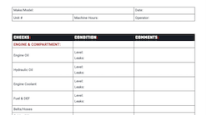Solar Power’s Future Looks Bright
This story appears in the Jan. 23 print edition of Equipment & Maintenance Update, a supplement to Transport Topics.
Many fleets are interested in harnessing free power from the sun to support ever-increasing electrical needs. However, successfully implementing solar power technology on today’s commercial vehicles requires careful planning and having the right application in mind.
 Chris Disantis
Chris DisantisSolar power is a green, emission-free power generation technology. It uses no fossil fuel and no greenhouse gases are generated during power production. Solar power is generated by converting the sun’s energy into direct current, or DC, electricity. The generated energy is typically stored in a battery. Once stored, this generated energy can be used at any time — day or night. It can be used as DC electricity or converted to alternating current, or AC, electricity using a DC to AC inverter.
Solar power has a variety of applications for commercial vehicles, but generally it’s used as an auxiliary means of recharging batteries within a typical vehicle electrical system.
A “solar power system” for vehicle applications usually includes one or more photovoltaic, or PV, modules that produce raw DC electricity, charge controller(s) to convert the raw DC electricity to conditioned DC power for use or storage in a battery, and all necessary wiring and electrical protection devices (e.g., fuses, disconnect switch) to safely transmit that power to its point of use or storage. Currently, the best-achieved sunlight conversion rate (solar module efficiency) is about 21.5% in new commercial products.
In commercial transport applications, solar power can be well-suited to charge primary or auxiliary battery systems. Primary batteries are used for engine starting or primary power. Auxiliary battery systems are used for systems such as lighting, liftgates, pumps, hotel loads, heating and cooling.
TMC has developed a new recommended practice — TMC RP 177, Solar Power for Commercial Vehicles — that covers important spec’ing and maintenance considerations for these systems. The document was developed under the S.1’s Solar Power for Commercial Vehicles Task Force, chaired by Bruce Purkey, chief creative engineer at Purkey’s Fleet Electric Inc.
“Solar power has a lot of potential for commercial vehicles, but it has to be done right and the application has to make sense — such as parasitic or ‘hotel’ loads,” Purkey said.
“Some equipment users have been implementing homegrown solar power solutions using a piecemeal approach, but that can have drawbacks,” he said. “TMC RP 177 gives equipment users a good overview of the technology and makes them better prepared to talk to solar power solutions providers about what sort of system might make sense for their specific application.”
Right-Sizing Is Important
According to RP 177, solar charging systems should be sized properly for the specific application. Sizing the system should consider the operating loads (average and peak) and the operating duration.
Storage battery capacity must be sufficient to power the load during times where sunlight is not present or when solar charging sun energy is not optimal. For transport solar, the operating locations or regions must be determined in order to estimate the amount of available sun energy.
Solar panel systems are rated in watts and the user will typically choose a system based on the rated wattage of the system versus the known system load. But choosing a system this way may result in insufficient solar capacity for the operating load.
Solar panels are tested under standard test conditions that are infrequently met in actual commercial vehicle and trailer applications. This means actual performance may vary from test performance conditions.
For example, a vehicle’s roof may be of a design which is flat, angled or radiused and thus may not be capable of tracking the sun. Also, the sun may not always be at an optimal angle relative to the solar panel, or may be partially or completely obscured and therefore would not perform as shown in ideal test conditions.
Many other variables affect onboard system performance as compared to solar panel test conditions, such as, among others:
• Calendar Day — The seasonal movement of the sun relative to the earth changes the amount of available sun energy. In the northern hemisphere, June has a maximum potential for solar energy but December and January can have 70% reductions of potential energy.
• Time of Day — Available light is minimal at sunrise, increasing to maximum daylight around noon, then decreasing until zero at sunset.
• Geographic Region — Potential solar energy is higher in the American southwest than in the North and varies based on sun angle and atmospheric conditions.
• Non Average Atmospheric Conditions — Heavy cloud cover, rain, snow, particulates and cloudy conditions can reduce irradiance by 20% to 40%. Heavy cloud cover associated with rain can remove most of the direct radiation from the sun and decrease the panel power up to 40% to 70%.
• Cell Temperature — The temperature of the panel during operation affects the output. A moving vehicle lowers the cell temperatures substantially depending on the air temperature and speed of the vehicle. A rise in temperature from 77 degrees fahrenheit to 130 could reduce the panel output by about 15% depending on cell type used in the panel. Consult manufacturer’s data for actual temperature losses/gains.
Solar Power Requirements and Load Profiles
Vehicle load profiles also may change seasonally and require more or less energy.
For example, a hydraulic liftgate system will require more energy for cold fluid pumping in the winter. A tractor cab auxiliary power unit climate control system will not be used for high-energy consumption A/C in the winter, but will still use power to circulate air from the cab heater. To properly size a solar system, all of the energy sources and loads must be identified and the average and worst cases analyzed to ensure sufficient sizing and proper design.
When initially determining the requirements of a solar charging system, the energy usage profile of the application should be recorded and studied. The energy profile information when recorded over a few weeks or a month can help to properly size the charging system.
Solar generation times (sunrise to sunset) and the amount of energy produced at any given time often do not match the consumption times and energy required for a given load so a battery is used to store the energy. For commercial transportation, energy loads are usually supplied from multiple sources, which also requires a battery to store energy from all sources.
Solar Panel Maintenance Considerations
Solar panel conversion efficiency, typically in the 20% range, is reduced by dust, grime, pollen and other particulates that accumulate on the solar panel. A dirty solar panel may reduce its power capabilities by up to 30% in high dust/pollen or desert areas.
For nonself-cleaning solar arrays, a professional window washing company can perform cleaning on a regular schedule. Solar panels are similar to the windows in a car, home or business. They get dirty from rain, dust, pollen, soot, smog, auto emissions, chimney ashes, bird droppings, leaves and other debris.
This dirt and debris blocks sunlight from being absorbed into the panels. The result is less green energy generation. The composition of the top sheet of the solar panel will affect how much dirt adheres to the panel.
Solar Panel Handing Considerations
As long as solar panels are exposed to light, they are generating electricity. Installers of solar power systems should understand the hazards and cautions related to the specific devices being installed.
Here are general safety guidelines for solar systems:
• Solar panels generate power when exposed to sunlight. Open circuit voltages are present at the panel lead wires all times during sun exposure.
• Installing solar panels on trucks and trailers carries a fall risk. Work with your safety manager to learn what precautions, training and personal protection equipment are required at your company for working off of the ground.
• Cover solar cells and isolate lead wires during installation.
• Do not “hot plug” solar panels due to risk of arc flash.
TMC RP 177 provides more detail about solar power construction and component design. More work is under way on another TMC recommended practice covering installation, troubleshooting and safety guidelines for solar power systems. For more information, contact TMC at (703) 838-1763; email: tmc@trucking.org.
Chris Disantis is chairman of the S.1 Electrical Study Group at American Trucking Associations’ Technology & Maintenance Council. He is director of training and field tech support for Aim NationaLease.



